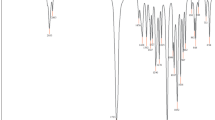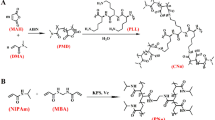Abstract
To be more biocompatible, poly(N-isopropyl acrylamide) (PNIPAM) hydrogel, as a typical temperature-sensitive hydrogel, is expected to be linked with other materials of excellent biocompatibility. For this propose, poly(N-isopropyl acrylamide)-block-poly(3-O-allyl-α-D-glucose) (PNIPAM-b-POAG), a new diblock copolymer, was successfully synthesized from N-isopropyl acrylamide (NIPAM) and 3-O-allyl-1,2:5,6-di-O-isopropynylene-α-D-glucose (OAIG) via reversible addition-fragmentation chain transfer (RAFT) polymerization in the presence of cumyl dithiobenzoate (CDB). PNIPAM-b-POAG was characterized byFourier transform infrared (FT-IR) spectroscopy, proton nuclear magnetic resonance (1H NMR) spectroscopy, and gel permeation chromatography (GPC). The critical micelle concentration (CMC) of the copolymer was 0.045 mg/ml measured by fluorescence spectroscopy. The copolymer solution exhibited a reversible sol-gel phase transitions with the increase or decrease of temperature. An in situ gel formed rapidly after subcutaneously injecting the copolymer solution into a Sprague Dawley (SD) rat, which indicated the copolymer has a good injectable property. The in vitro release result showed that methylene blue (MB) as a model was sustainably released by the temperature-sensitive PNIPAM-b-POAG diblock copolymer at 37 °C within 120 h. The copolymer showed no apparent cytotoxicity on L929 cells by 3-(4,5-Dimethylthiazol-2-yl)-2,5-diphenyltetrazolium bromide (MTT) assay. The novel temperature-sensitive hydrogel is a promising candidate for drug delivery.











Similar content being viewed by others
References
Gil ES, Hudson SM (2004) Stimuli-reponsive polymers and their bioconjugates. Prog Polym Sci 29:1173–1222. doi:10.1016/j.progpolymsci.2004.08.003
Dayananda K, He C, Park DK, Park TG, Lee DS (2008) pH- and temperature-sensitive multiblock copolymer hydrogels composed of poly(ethylene glycol) and poly(amino urethane). Polymer 49:4968–4973. doi:10.1016/j.polymer.2008.09.033
Peppas NA, Hilt JZ, Khademhosseini A, Langer R (2005) Hydrogels in biology and medicine: from molecular principles to bionanotechnology. Adv Mater 18:1345–1360. doi:10.1002/adma.200501612
Wang Y, Chen D (2012) Preparation and characterization of a novel stimuli-responsive nanocomposite hydrogel with improved mechanical properties. J Colloid Interf Sci 372:245–251. doi:10.1016/j.jcis.2012.01.041
Herber S, Olthuis W, Bergveld P, Berg AVD (2004) Exploitation of a pH-sensitive hydrogel disk for CO 2 detection. Sens Actuators B 103:284–289. doi:10.1016/j.snb.2004.04.113
He C, Kim SW, Lee DS (2008) In situ gelling stimuli-sensitive block copolymer hydrogels for drug delivery. J Control Release 127:189–207. doi:10.1016/j.jconrel.2008.01.005
Huynh DP, Shim WS, Kim JH, Lee DS (2006) pH/temperature sensitive poly(ethylene glycol)-based biodegradable polyester block copolymer hydrogels. Polymer 47:7918–7926. doi:10.1016/j.polymer.2006.09.021
Huynh CT, Nguyen QV, Kang SW, Lee DS (2012) Synthesis and characterization of poly(amino urea urethane)-based block copolymer and its potential application as injectable pH/temperature-sensitive hydrogel for protein carrier. Polymer 53:4069–4075. doi:10.1016/j.polymer.2012.07.031
Song J, Yu R, Wang L, Zheng S, Li X (2011) Poly(N-vinylpyrrolidone)-grafted poly(N-isopropylacrylamide) copolymers: synthesis, characterization and rapid deswelling and reswelling behavior of hydrogels. Polymer 52:2340–2350. doi:10.1016/j.polymer.2011.03.038
Zhang B, He W, Li L, Sun X, Li W, Zhang K (2010) Reducibly degradable hydrogels of PNIPAM and PDMAEMA: synthesis, stimulus-response and drug release. J Polym Sci Part A Polym Chem 48:3604–3612. doi:10.1002/pola.24141
JagadeeshBabu PE, Sures Kumar R, Maheswari B (2011) Synthesis and characterization of temperature sensitive P-NIPAM macro/micro hydrogels. Colloids Surf A Physicochem Eng Asp 384:466–472. doi:10.1016/j.colsurfa.2011.05.004
Zadražil A, Štěpánek F (2010) Investigation of thermo-responsive optical properties of a composite hydrogel. Colloids Surf A Physicochem Eng Asp 372:115–119. doi:10.1016/j.colsurfa.2010.09.039
Kohori F, Sakai K, Aoyagi T, Yokoyama M, Sakurai Y, Okano T (1998) Preparation and characterization of thermally responsive block copolymer micelles comprising poly(N-isopropylacrylamide-b-D, L-lactide). J Control Release 55:87–98. doi:10.1016/ S0168-3659(98)00023-6
Hamcerencu M, Desbrieres J, Popa M, Riess G (2012) Original stimuli-sensitive polysaccharide derivatives/N-isopropylacrylamide hydrogels. Role of polysaccharide backbone. Carbohydr Polym 89:438–447. doi:10.1016/j.carbpol.2012.03.026
Varghese JM, Ismail YA, Lee CK, Shin KM, Shin MK, Kim SI, So I, Kim SJ (2008) Thermoresponsive hydrogels based on poly(N-isopropylacrylamide)/chondroitin sulfate. Sens Actuators B 135:336–341. doi:10.1016/j.snb.2008.09.001
Hu YQ, Kim MS, Kim BS, Lee DS (2007) Synthesis and pH-dependent micellization of 2-(diisopropylamino)ethyl methacrylate based amphiphilic diblock copolymers via RAFT polymerization. Polymer 48:3437–3443. doi:10.1016/j.polymer.2007.04.011
Smith AE, Xu X, McCormick CL (2010) Stimuli-responsive amphiphilic (co)polymers via RAFT polymerization. Prog Polym Sci 35:45–93. doi:10.1016/j.progpolymsci.2009.11.005
Keddie DJ, Moad G, Rizzardo E, Thang SH (2012) RAFT Agent Design and Synthesis. Macromolecules 45:5321–5342. doi:10.1021/ma300410v
**n X, Wang Y, Liu W (2005) Synthesis of zwitterionic block copolymers via RAFT polymerization. Eur Polym J 41:1539–1545. doi:10.1016/j.eurpolymj.2005.01.015
Torrente S, Noya B, Branchadell V, Alonso R (2003) Intra- and Intermolecular 1,3-Dipolar Cycloaddition of Sugar Ketonitrones with Mono-, Di-, and Trisubstituted Dipolarophiles. J Org Chem 68:4772–4783. doi:10.1021/jo034159g
Carlucci M, Kierzek E, Olejnik A, Turner DH, Kierzek R (2009) Chemical Synthesis of LNA-2-thiouridine and Its Influence on Stability and Selectivity of Oligonucleotide Binding to RNA. Biochemistry 48:10882–10893. doi:10.1021/bi901506f
Abandansari HS, Aghaghafari E, Nabid MR, Niknejad H (2013) Preparation of injectable and thermoresponsive hydrogel based on penta-block copolymer with improved sol stability and mechanical properties. Polymer 54:1329–1340. doi:10.1016/j.polymer.2013.01.004
Acknowledgments
This work was supported by National Natural Science Foundation of China (No. 21376124, 21006054) and Natural Training Programs of Innovation for Undergraduates (No.201310304019Z).
Author information
Authors and Affiliations
Corresponding author
Rights and permissions
About this article
Cite this article
Tang, Y., Zhang, S., Wang, M. et al. A glucose-based diblock copolymer: synthesis, characterization and its injectable/temperature-sensitive behaviors. J Polym Res 21, 390 (2014). https://doi.org/10.1007/s10965-014-0390-y
Received:
Accepted:
Published:
DOI: https://doi.org/10.1007/s10965-014-0390-y




